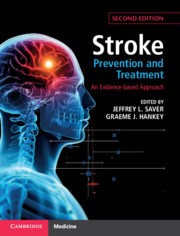Book contents
- Stroke Prevention and Treatment
- Stroke Prevention and Treatment
- Copyright page
- Dedication
- Contents
- Contributors
- Preface
- Part I Foundations
- Part II Systems of Care
- Part III Acute Treatment of Ischaemic Stroke and Transient Ischaemic Attack
- Chapter 5 Supportive Care during Acute Cerebral Ischaemia
- Chapter 6 Reperfusion of Ischaemic Brain by Intravenous Thrombolysis
- Chapter 7 Reperfusion of the Ischaemic Brain by Endovascular Thrombectomy and Thrombolysis
- Chapter 8 Collateral Flow Enhancement: Blood Pressure Lowering and Alteration of Blood Viscosity
- Chapter 9 Acute Antiplatelet Therapy for the Treatment of Ischaemic Stroke and Transient Ischaemic Attack
- Chapter 10 Acute Anticoagulant Therapy for the Treatment of Acute Ischaemic Stroke and Transient Ischaemic Attack
- Chapter 11 Treatment of Brain Oedema
- Chapter 12 Neuroprotection for Acute Brain Ischaemia
- Part IV Acute Treatment of Haemorrhagic Stroke
- Part V Prevention
- Part VI Stroke Rehabilitation and Recovery
- Index
- References
Chapter 11 - Treatment of Brain Oedema
from Part III - Acute Treatment of Ischaemic Stroke and Transient Ischaemic Attack
Published online by Cambridge University Press: 15 December 2020
- Stroke Prevention and Treatment
- Stroke Prevention and Treatment
- Copyright page
- Dedication
- Contents
- Contributors
- Preface
- Part I Foundations
- Part II Systems of Care
- Part III Acute Treatment of Ischaemic Stroke and Transient Ischaemic Attack
- Chapter 5 Supportive Care during Acute Cerebral Ischaemia
- Chapter 6 Reperfusion of Ischaemic Brain by Intravenous Thrombolysis
- Chapter 7 Reperfusion of the Ischaemic Brain by Endovascular Thrombectomy and Thrombolysis
- Chapter 8 Collateral Flow Enhancement: Blood Pressure Lowering and Alteration of Blood Viscosity
- Chapter 9 Acute Antiplatelet Therapy for the Treatment of Ischaemic Stroke and Transient Ischaemic Attack
- Chapter 10 Acute Anticoagulant Therapy for the Treatment of Acute Ischaemic Stroke and Transient Ischaemic Attack
- Chapter 11 Treatment of Brain Oedema
- Chapter 12 Neuroprotection for Acute Brain Ischaemia
- Part IV Acute Treatment of Haemorrhagic Stroke
- Part V Prevention
- Part VI Stroke Rehabilitation and Recovery
- Index
- References
Summary
Among medical therapies, osmotherapy with colloidal agents (mannitol, glycerol) or crystalloid agents (hypertonic saline) is reasonable for patients whose condition is deteriorating due to mass effect and herniation from large anterior circulation hemispheric or cerebellar infarcts, especially as bridging therapies to definitive surgical intervention. Hyperventilation and hypothermia may also be reasonable, though are of less certain benefit. Corticosteroids have not been found helpful. Agents that block sulfonylurea receptor-mediated cellular swelling, such as intravenous glyburide, have shown promise but require pivotal trial testing. Ventriculostomy is useful to treat non-communicating hydrocephalus arising from obstruction of CSF flow pathways by swollen brain infarcts. But in select large cerebellar infarcts, ventricular drainage alone may exacerbate upward herniation of swollen cerebellar tissues, and suboccipital craniectomy along with ventricular drainage is preferred. Suboccipital craniectomy, often with resection of infarcted tissue, is recommended for massive cerebellar infarcts that may herniate directly into the brainstem, on the basis of observational evidence. Hemicraniectomy for brain oedema associated with large anterior circulation hemispheric infarction is life-saving, but survivors often have severe disability, especially when over age 60. If pursued, hemicraniectomy is generally best performed within 48 h of onset and before development of advanced herniation and neurological deterioration.
Keywords
- Type
- Chapter
- Information
- Stroke Prevention and TreatmentAn Evidence-based Approach, pp. 199 - 213Publisher: Cambridge University PressPrint publication year: 2020



